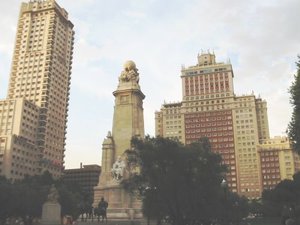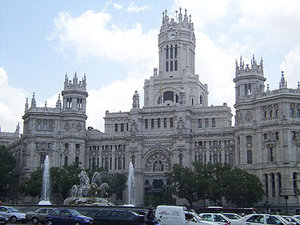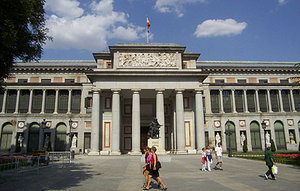Madrid
|
|
Madrid, the capital of Spain, is located in the center of the country at Template:Coor dm. Population of the city of Madrid proper was 3,093,000 (Madrilenes, madrile�os) as of 2003 estimates. Population of the urban area was 4,791,000 as of 2000 estimates. Population of the metropolitan area (urban area plus satellite towns) was 5,603,000 as of 2003 estimates.
Madrid is the capital not only of the country but also of the province and autonomous community of Madrid.
As of 2004, the mayor of Madrid is Alberto Ruiz-Gallard�n.
| Contents |
History
Karte_Madrid_MKL1888.png
Although the site of Madrid has been occupied since prehistoric times, the first historical data we have from the city is from the middle of the IX Century, when Mohamed I ordered the construction of a small palace (in the same place that is occupied now by the Palacio Real). Around this palace there was built a small citadel (al-Mudaina). Near that palace was the River Manzanares, which the Muslims called al-Maǧrīṭ (Arabic المجريط) meaning "source of water". (whence Magerit, then Madrid). The citadel was conquered in 1085 by Alfonso VI in his advance towards Toledo. He reconsecrated the mosque as the church of the Virgin of Almudena (almudin, the garrison's granary). In 1329 the Cortes first assembled in Madrid to advise Fernando IV. Jews and Moors continued to live in the city in their quarter, still called the "Moreria" until they were expelled and every mosque and synagogue was utterly obliterated.
After troubles and a fire Enrique III (1379-1406) rebuilt the city and established himself safely fortified outside its walls in El Pardo. The grand entry of Ferdinand and Isabella into Madrid signalled the end of strife between Castile and Aragon.
The kingdoms of Castilla, with its capital at Toledo, and Arag�n, with its capital at Barcelona, were welded into modern Spain in the person of Carlos I. Though King Carlos favored Madrid, it was his son, Felipe II (1527-1598) who moved the Court to Madrid in 1561. Although he made no official declaration, the seat of the Court was the de facto capital. Seville continued to control the Spanish Indies, but Madrid controlled Seville. Aside from a brief period, 1601 - 1606, when Felipe III installed his court in Valladolid, Madrid's fortunes have closely mirrored those of Spain. During the Siglo de Oro (Golden Century), in the XVI/XVII century, Madrid had no resemblance with other European capitals: the population of the city was economically dependent on the business of the court itself.
Felipe V decided that a European Capital could not stay in such a state, and new palaces (including the Palacio Real de Madrid) were built during his reign. However, it would not be until Carlos III (1716-1788) that Madrid would become a modern city. Carlos III was one of the most popular kings in the history of Madrid, and the saying "the best mayor, the king" became popular during those times. When Carlos IV (1748-1819) became king the people of Madrid revolted. After the Mutiny of Aranjuez which was impulsed by his own son Fernando VII against him, Carlos IV resigned, but Fernando VII reign would be short: in May of 1808 Napoleon's troops entered the city. On May 2, 1808 (Spanish: Dos de Mayo) the Madrilenes revolted against the French forces, whose brute reaction would have a lasting impact on French rule in Spain and France's image in Europe in general.
After the war of independence (1814) Fernando VII came back to the throne, but after a liberal military revolution, Colonel Riego made the king swear respect to the Constitution. This would start a period where liberal and conservative alternate government, that would end with the enthronement of Isabel II (1830-1904), who would not be able to calm down the political tension that would lead to yet another revolt, the First Spanish Republic, the comeback of the monarchs which eventually would lead to the Second Spanish Republic and the Spanish Civil War. During this war (1936-1939) Madrid would be one of the most affected cities and its streets became battlezones.
During the Catholic dictatorship of Francisco Franco, Madrid became very industrialized and there were massive migrations into the city. Towards the end of the dictatorship the Basque terrorist group ETA assassinated Franco's prime minister, Luis Carrero Blanco, in the Street of Claudio Coello. As anything related to ETA, this incident is still today a matter of controversy; while some think that it created further instability, others hold that the terrorist action--by impeding that Carrero Blanco would continue the dictatorship after Franco's death--contribute to lead the country towards democracy.
After the death of Franco, emerging democratic parties (including those of left-wing and republican ideology) accepted Franco's wishes of being succeedled by Juan Carlos I--in order to secure stablity and democracy--which led Spain to its current position as constitutional monarchy.
Befitting from the prosperity it gained in the 1980s, the capital city of Spain has consolidated its position as the leading economic, cultural, industrial, educational, and technological center on the Iberian peninsula.
Contemporary Madrid
Contemporary Madrid came into its own after the death of the Fascist dictator Franco. Years of the Franco regime left Madrid and much the country in economic shambles due to isolation. With his death, Madrid and Spain as a whole began to re-assert itself on the international stage. Within Spain, reaction against the dictatorial bureaucracy centered in Madrid and a history of centralism that pre-dated Franco by centuries has resulted in the successful modern movement towards increased autonomy for the regions of Spain, considered as European regions, under the umbrella of Spain.
Modern Madrid ranks as an important city in Europe. By attempting to establish itself as the leading southern European city and the most important link between the European Union and Latin America, the city is still in the midst of its transformation.
The modern metropolis is home to over three million people. As expected with any major European capital city, each district (or barrio in Spanish) has its own feel.
Alonso Mart�nez
This district contains the large Plaza de Col�n. This plaza commemorates Christopher Columbus, who was responsible for ushering in the Spanish imperial golden age of the 16th and 17th centuries. This district also contains the main bus terminal as it is a central point of the city. It is within walking distance of the main cultural and commercial areas of the city such as the Prado museum, the expansive Parque del Buen Retiro as well as near the business center on the lower part of the Paseo de la Castellana.
Atocha
Atocha includes a rather large area which is bordered by the Huertas and Lavapi�s districts. The two important sites located in this area are the Reina Sof�a Museum and the Atocha Railway Station, one of the two main train stations in Madrid (the other one is Chamart�n). The area also contains a number of art galleries and restaurants serving traditional food.
AZCA / Nuevos Ministerios
This is the financial district. The area is populated by skyscrapers, among them Torre Picasso, Edificio BBVA and Torre Europa. Torre Windsor, one of the skycrapers in this area, burnt entirely on the night between 12 February and 13, 2005 [1] (http://www.elmundo.es/elmundo/2005/graficos/feb/s3/windsorfotos.html).
A very large (3 interconnected buildings) El Corte Ingl�s department store is also here.
The area is directly linked to Barajas Airport by metro line 8 from Nuevos Ministerios station.
Chueca
Main article: Chueca
Chueca is among the most authentic and cosmopolitan neighborhoods in the downtown city center. This district was the site of major urban decay during the early 1980s. However, later on during the decade. it became one of the most active centers of the so-called 'La Movida', largely due to its new-found status as a popular gay village. It is still quite attractive and has many good and interesting places to eat, as well as some of Madrid's most avant garde fashion and shoe shops.
Las Cortes
This district is small in size but packs a number of powerful sites. The most important include Spanish parliament buildings of the lower house Congreso de los Diputados as well as the upper house, the Senate (El Senado). It also includes one of the three museums of the Madrid golden triangle, the Thyssen-Bornemisza Museum. In addition, we find the highly ornate Banco de Espa�a, the Caf� del C�rculo de Bellas Artes, the Zarzuela theater.
Gran V�a
As the name implies, the Gran V�a district contains one of Madrid's most important avenues, the Gran V�a (literally, "Broadway") First and foremost it is a shopping street, but it also contains a number of tourist accommodations, plenty of nightlife and most of Madrid's largest movie theaters. It is also a hub for Madrid's red-light district, especially the side streets. One of those streets, Fuencarral has become a link between the old shopping areas of the center of the city, the Bohemian Malasa�a and the hip Chueca, making of it a very cosmopolitan area that has helped Madrid to take one step closer to other European cities such as Barcelona and London.
Huertas-Lavapi�s
Traditionally one of the poorer neighborhoods near the city center, this district has maintained much of true 'Madrile�o' spirit of the past. Lavapi�s is one of the areas with a high concentration of immigrants, and also tends to attract artists and writers adding to the cosmopolitan mix. The presence of immigrants has led to an inevitable variety of shops and restaurants - this is a good place for good and cheap restaurants of local and international food. It's also one of the best places to search for non-Spanish foodstuff, (herbs and spices etc.) Due to its immigrant character and the fact that the terrorists responsible for the Madrid train bombings of 11 March 2004, were based in Lavapi�s (in particular, in a popular Moroccan restaurant called Al-Baraka), there are substantiated fears of crime in this district.
La Latina
In and around this area are the origins of Madrid. Its difficult to put precise boundaries on La Latina, because, like its immediate neighbors, streets are narrow and wind a lot. There are quite a few nightlife spots. There are also a number of attractive churches as well as Madrid's town hall. Bordering on La Latina's east side is the famous Rastro flea-market (a prime pick-pocket spot).
Malasa�a
Malasa�a is a vibrant neighborhood full of lively bars and clubs overflowing with young people. Its streets are currently being renovated, making it a much more attractive quarter (the streetworks are almost finished). It's one of the classic areas for partying the night away. The area's center is the Plaza del Dos de Mayo (in commemoration of the Madrilenian popular uprising on May 2, 1808, brutally and effectively repressed by the French troops and which started the Spanish Independence War).
Although popularly known as the barrio Malasa�a, the
real name for the area is Universidad (University).
The name Malasa�a comes from the 17 year old girl
Manuela Malasa�a who once lived on the street
San Andr�s. She was killed fighting the French in 1808.
Today there is a street named in her honour very close
to the roundabout 'Glorieta de Bilbao'.
Vallecas
Vallecas is a poor working-class residential district in the south of Madrid. It is also home to the Rayo Vallecano soccer team.
Tourist attractions
Important cultural and tourist spots include the so-called Golden Triangle of Art, located along the Paseo del Prado and comprising the famous Prado Museum,free on Sunday mornings, (with highlights such as Diego Vel�zquez's Las Meninas and Francisco de Goya's La Maja vestida and La Maja desnuda), the Thyssen Bornemisza Museum and the Reina Sofia Museum (where Pablo Picasso's Guernica hangs); the Plaza Mayor; the Gran Via; the Cas�n del Buen Retiro (hosting the 19th-century collection of the Prado Museum; currently closed for reform), the Palacio Real, the Templo de Debod (a temple brought stone-by-stone from Egypt), the Monasterio de las Descalzas Reales, the Puerta del Sol and the Parque del Buen Retiro.
Madrid is also host to one of the most famous bullfighting rings in the world, Las Ventas [2] (http://www.las-ventas.com/).
Other nearby towns are popular as day trips from Madrid, including Toledo, Segovia, �vila, Aranjuez, Alcal� de Henares, the monastery and palace complex of El Escorial, and Chinch�n.
Other notable structures
- Torre Espa�a
- Faro de Moncloa (Transmission tower with observation deck)
- Puerta de Europa (Famous towers leaning toward eachother at 15 degree angle)
- Puerta de Alcal� (An old gate for the city walls that is nowadays one of the most emblematic signs of Madrid)
Nightlife
Madrid is also noted for its nightlife and discotheques. Younger madrile�os sometimes dance all night, stop off for chocolate y churros at dawn, go home, shower, shave, and go to work. This nightlife, called la movida or la marcha and initially focussed on the Plaza del Dos de Mayo, flourished after the death of Franco, especially during the 80's while Madrid's most cherished mayor Enrique Tierno Galv�n was in office. A particular hub for this night activity is nowadays the nearby gay village of Chueca. However, as prices continue to rise and more jobs become available, nightlife in Madrid is becoming more and more like that of other European cities such as Stockholm or Munich.
Universities
Madrid is the largest hub in Spain for university life, though the academic centre is in Salamanca.
Universidad Complutense de Madrid
The Complutense University is one of the oldest universities in the world, and the largest in Spain. It has 10000 staff and a student population of 117 000. It is located on two campuses, in the university quarter Ciudad Universitaria at Moncloa in Madrid, and in Somosaguas.
The Complutense University has its origins in the 13th century on the banks of the river Henares. The university achieved the name "Complutense" due to the fact that it was originally situated in the town of Alcal� de Henares, whose Latin name was Complutum. After 1836 the university was moved to Madrid and renamed Universidad Central. The campus in the Ciudad Universitaria quarter in Madrid was built starting in 1927, and around 1980 a secondary campus was created in the neighbouring town of Somosaguas. The old Alcala campus reopened as an independent university (Universidad de Alcal� de Henares) in 1977.
Other Universities
- Universidad de Alcal� de Henares(Alcal� (http://www.uah.es))
- Universidad Aut�noma de Madrid (UAM (http://www.uam.es))
- Universisad Carlos III de Madrid(Carlos III (http://www.uc3m.es))
- Universidad Polit�cnica de Madrid (UPM (http://www.upm.es))
- Universidad Rey Juan Carlos (Rey Juan Carlos (http://www.urjc.es))
- Universidad Nacional de Educaci�n a Distancia (UNED (http://www.uned.es))
- Universidad Alfonso X el Sabio(UAX (http://www.uax.es/))
- Universidad Antonio de Nebrija (Nebrija (http://www.nebrija.com))
- Universidad Camilo Jos� Cela (Cela (http://www.ucjc.es))
- Universidad Europea de Madrid (UEM (http://www.uem.es))
- Universidad Francisco de Vitoria (Francisco de Vitoria (http://www.fvitoria.com))
- Universidad Pontificia Comillas (ICADE-ICAI (http://www.upco.es))
- Universidad Pontificia de Salamanca (UPSAM (http://www.upsam.com))
- Universidad San Pablo (CEU (http://www.ceu.es))
- Escuela de Organizaci�n Industrial (EOI (http://www.eoi.es))
- Facultad de Ciencias del Seguro, Jur�dicas y de la Empresa
- Fundaci�n General de la Universidad de Alcal�
Transportation
Air
Madrid is served by Barajas International Airport. Barajas serves as the main hub of recently privatized Iberia Airlines. It consequently serves as the main gateway to the Iberian peninsula from Europe and the rest of the world. Current passenger volumes range upwards of 40 million passengers per year, putting it in the top 20 busiest airports in the world. Given annual increases of 10%, a new fourth and fifth terminals are in the process of being constructed. It is expected to significantly reduce delays and double the capacity of the airport. Two additional runways have also being constructed and will soon be in operation, making Barajas a fully operational 4 runway airport.
National Rail
Spain's public railway system, the Red Nacional de Ferrocarriles Espa�oles (Renfe) operates the vast majority of Spain's railways. In Madrid, the main rail terminals are Atocha and Chamart�n.
The crown jewel of Spain's next decade of infrastructure construction is the Spanish high speed rail network, Alta Velocidad Espa�ola AVE. Currently, an ambitious plan includes the construction of a 7000 km network, centered naturally on Madrid. The overall goal is to have all important provincial cities be no more than 4 hours away from Madrid, and no more than 6 hours away from Barcelona. Currently, AVE high-speed trains link Atocha station to Seville in the south and Lleida in the east (to be extended to Barcelona).
Metro
Serving the city's population of some three million, the Madrid Metro is one of the most extensive and fastest-growing metro networks in the world. With the addition of a loop serving suburbs to Madrid's south-west "Metrosur", it is now the second largest metro system in Western Europe, second only to London's Underground. The province of Madrid is also served by an extensive commuter rail network called Cercan�as.
Sports
Madrid is home to Real Madrid, the world's most successful football club (according to FIFA). There are four other major teams, the Primera Division club Atl�tico de Madrid, Rayo Vallecano and Getafe Club de Futbol.
Olympic Candidature
Madrid is candidate city to host the Olympic Games of the 30th Olympiad in 2012.
The IOC selected the city the 18th of May 2004 the five candidate cities to host the 2012 Olympic Games: Madrid, Paris, London, New York and Mosccow. On 6th July 2005, IOC will decide the city that wil host the 2012 Games. An IOC delegation visited Madrid in February to evaluate the candidature.
The logo designed by spaniard Javier Mariscal is: [[3] (http://www.madrid2012.es/images/Multimedia/salvapantallas/Foto_imagen_candidatura.gif)]






